
The American Civil War was a civil war in the United States between the Union and the Confederacy, which was formed in 1861 by states that had seceded from the Union. The central conflict leading to the war was a dispute over whether slavery should be permitted to expand into the nation's western territories, leading to more slave states, or be prohibited from doing so, which many believed would place slavery on a course of ultimate extinction.
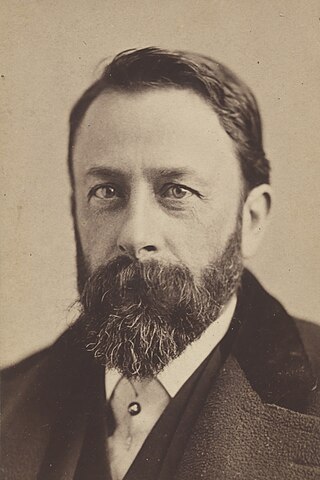
Albert Bierstadt was a German American painter best known for his lavish, sweeping landscapes of the American West. He joined several journeys of the Westward Expansion to paint the scenes. He was not the first artist to record the sites, but he was the foremost painter of them for the remainder of the 19th century.
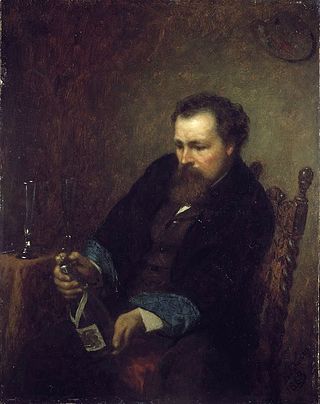
Jonathan Eastman Johnson was an American painter and co-founder of the Metropolitan Museum of Art, New York City, with his name inscribed at its entrance. He was best known for his genre paintings, paintings of scenes from everyday life, and his portraits both of everyday people and prominent Americans such as Abraham Lincoln, Nathaniel Hawthorne, Ralph Waldo Emerson, and Henry Wadsworth Longfellow. His later works often show the influence of the 17th-century Dutch masters, whom he studied in The Hague in the 1850s; he was known as The American Rembrandt in his day.

The Battle of Appomattox Court House, fought in Appomattox County, Virginia, on the morning of April 9, 1865, was one of the last battles of the American Civil War (1861–1865). It was the final engagement of Confederate General in Chief Robert E. Lee and his Army of Northern Virginia before they surrendered to the Union Army of the Potomac under the Commanding General of the United States Army, Ulysses S. Grant.
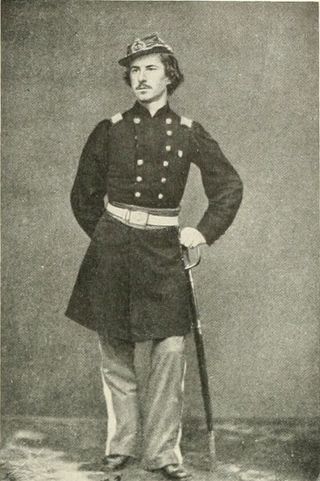
Elmer Ephraim Ellsworth was a United States Army officer and law clerk who was the first conspicuous casualty and the first Union officer to die in the American Civil War. He was killed while removing a Confederate flag from the roof of the Marshall House inn in Alexandria, Virginia.

{{Infobox military person |name=Julian A. Scott |birth_date= February 14, 1846 |death_date= July 4, 1901 (aged 55) |image=Julian-scott-cdv.JPG |caption= |nickname= |birth_place=Johnson, Vermont, US |death_place=Plainfield, New Jersey, US |allegiance= [[United States
Union |branch= United States Army]]
Union Army |serviceyears= 1861 - 1863 |rank= Drummer |unit= 3rd Vermont Infantry |commands= |battles=American Civil War
*Battle of Lee's Mills |awards=Medal of Honor |relations= |laterwork= }} Julian A. Scott, was born in Johnson, Vermont, and served as a Union Army drummer during the American Civil War, where he received America's highest military decoration the Medal of Honor for his actions at the Battle of Lee's Mills. He was also an American painter and Civil War artist.
Don Troiani is an American painter whose work focuses on his native country's military heritage, mostly from the American Revolution, War of 1812 and American Civil War. His highly realistic and historically accurate oil and watercolor works are most well known in the form of marketed mass-produced printed limited-edition reproductions, illustrated books, book compilations, museum and government collections. He is also a militaria collector.

Sonya Clark is an American artist of Afro-Caribbean heritage. Clark is a fiber artist known for using a variety of materials including human hair and combs to address race, culture, class, and history. Her beaded headdress assemblages and braided wig series of the late 1990s, which received critical acclaim, evoked African traditions of personal adornment and moved these common forms into the realm of personal and political expression. Although African art and her Caribbean background are important influences, Clark also builds on practices of assemblage and accumulation used by artists such as Betye Saar and David Hammons.

Joseph Hirsch (1910–1981) was an American painter, illustrator, muralist and teacher. Social commentary was the backbone of Hirsch's art, especially works depicting civic corruption and racial injustice.

David Bustill Bowser was a 19th-century African-American ornamental artist, portraitist, and social activist. He designed battle flags for eleven African-American regiments during the American Civil War and painted portraits of prominent Americans, including U.S. President Abraham Lincoln and abolitionist John Brown. Politically active throughout much of his adult life, he was a contributor to the Undergrounds Railroad and also helped to secure the post-war passage of key civil rights legislation in Pennsylvania.

A Visit from the Old Mistress is an 1876 painting by the American artist Winslow Homer. It was one of several works that Homer is thought to have created during a mid-1870s visit to Virginia, where he had served for a time as a Union war correspondent during the American Civil War. Scholars have noted that the painting's composition is taken from Homer's earlier painting Prisoners from the Front, which depicts a group of captive Confederate soldiers defiantly regarding a Union officer. Put on display in the northern states for a northern audience, A Visit from the Old Mistress, along with Homer's other paintings of black southern life from the Reconstruction era, has been praised as an "invaluable record of an important segment of life in Virginia during the Reconstruction."

Aurora Borealis is an 1865 painting by the American artist Frederic Edwin Church of the aurora borealis and the Arctic expedition of Isaac Israel Hayes. The painting measures 142.3 by 212.2 centimetres and is now owned by the Smithsonian American Art Museum.

The Lord Is My Shepherd is an 1863 oil-on-wood painting by American artist Eastman Johnson. The painting measures 16 5/8 x 13 1/8 in. and is on display at the Smithsonian American Art Museum, in Washington, D.C.

Eleanor Jones Harvey is a senior curator at the Smithsonian American Art Museum.

The Bright Side is an oil painting by the American artist Winslow Homer. Painted in 1865, the concluding year of the American Civil War, the work depicts four African American Union Army teamsters sitting on the sunny side of a Sibley tent. The painting is in the collection of the Fine Arts Museums of San Francisco-(De Young)
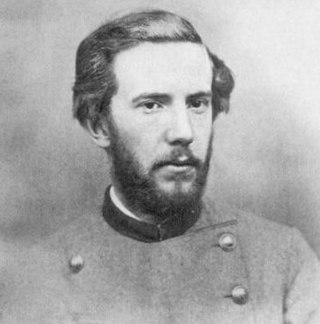
Conrad Wise Chapman was an American painter who served in the Confederate States Army from 1861 to 1865.

Negro Life at the South (1859) is a painting by American artist Eastman Johnson that depicts the private life of African-American slaves in Washington, D.C. It was painted in Washington, D.C., and is now owned by the New York Public Library, on permanent loan to the New-York Historical Society. Johnson also created two versions of the painting in the 1870s, now owned by the High Museum of Art in Atlanta.

The Commemoration of the American Civil War on postage stamps concerns both the actual stamps and covers used during the American Civil War, and the later postage celebrations. The latter include commemorative stamp issues devoted to the actual events and personalities of the war, as well as definitive issues depicting many noteworthy individuals who participated in the era's crucial developments.
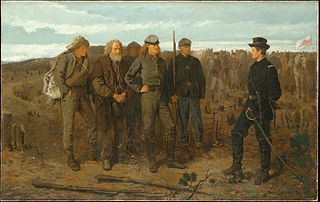
Prisoners from the Front is an 1866 painting by American artist Winslow Homer. One of Homer's most notable early works, the painting depicts a scene in which Confederate officers surrender to Union Brigadier General Francis Channing Barlow during the American Civil War. Homer's experience as a war correspondent likely contributed to his rendering of the work.
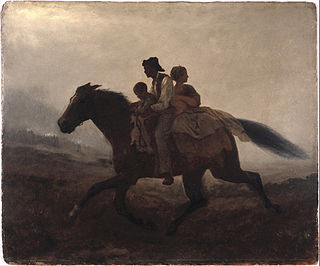
A Ride for Liberty – The Fugitive Slaves (1862) is a painting by the American artist Eastman Johnson that depicts a family of African Americans fleeing enslavement in the Southern United States during the American Civil War. It is based on an event that Johnson claimed to have witnessed near Manassas, Virginia, on March 2, 1862.



















